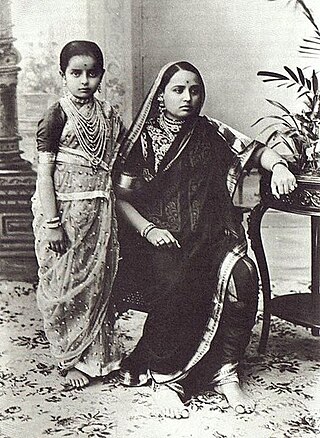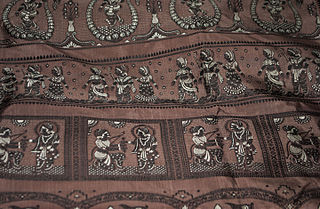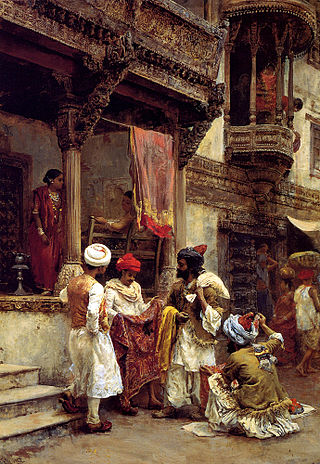Related Research Articles

Textile is an umbrella term that includes various fiber-based materials, including fibers, yarns, filaments, threads, different fabric types, etc. At first, the word "textiles" only referred to woven fabrics. However, weaving is not the only manufacturing method, and many other methods were later developed to form textile structures based on their intended use. Knitting and non-woven are other popular types of fabric manufacturing. In the contemporary world, textiles satisfy the material needs for versatile applications, from simple daily clothing to bulletproof jackets, spacesuits, and doctor's gowns.

Velvet is a type of woven tufted fabric in which the cut threads are evenly distributed, with a short pile, giving it a distinctive soft feel. By extension, the word velvety means "smooth like velvet". In the past, velvet was typically made from silk. Today, velvet can be made from linen, cotton, wool and synthetic fibers.

A sari is a women's garment from the Indian subcontinent, that consists of an un-stitched stretch of woven fabric arranged over the body as a robe, with one end tied to the waist, while the other end rests over one shoulder as a stole (shawl), sometimes baring a part of the midriff. It may vary from 4.1 to 8.2 metres in length, and 60 to 120 centimetres in breadth, and is form of ethnic wear in India, Pakistan, Bangladesh, Sri Lanka and Nepal. There are various names and styles of sari manufacture and draping, the most common being the Nivi style. The sari is worn with a fitted bodice commonly called a choli and a petticoat called ghagra, parkar, or ul-pavadai. It remains fashionable in the Indian Subcontinent today.
Longcloth refers to a plain cotton cloth originally made in comparatively long pieces.

Phulkari refers to the folk embroidery of the Punjab. Although Phulkari means floral work, the designs include not only flowers but also cover motifs and geometrical shapes. The main characteristics of Phulkari embroidery are use of darn stitch on the wrong side of coarse cotton cloth with coloured silken thread. Punjabi women create innumerable alluring and interesting designs and patterns by their skilful manipulation of the darn stitch. According to Kehal (2009), a cloth where only a few flowers are embroidered is called a Phulkari. The other types are distinct varieties. The traditional varieties of Phulkaris are large items of cloth and include Chope, Tilpatr, Neelak and Bagh. Sometimes, the Bagh is given separate categorization of its own as on other varieties of a Phulkari, parts of the cloth is visible, whereas in a Bagh, the embroidery covers the entire garment so that the base cloth is not visible. Further, in contemporary modern designs, simple and sparsely embroidered dupattas, odhinis, and shawls, made for everyday use, are referred to as phulkaris, whereas clothing items that cover the entire body, made for special and ceremonial occasions such as weddings are called baghs. The Phulkari continues to be an integral part of Punjabi weddings to the present day.
Rahon is a city and a municipal council in the district Shaheed Bhagat Singh of the Indian state of Punjab. Rahon is in Doaba region of Punjab. Doaba also known as Bist Doab, is the region of Punjab, India that lies between the Beas River and the Sutlej River. A famous battle was fought here between Sikhs and Mughals i.e Battle of Rahon (1710).

Silk In India, about 97% of the raw mulberry silk is produced in the Indian states of Karnataka, Andhra Pradesh, Tamil Nadu and West Bengal. Mysore and North Bangalore, the upcoming site of a US$20 million "Silk City", contribute to a majority of silk production. Another emerging silk producer is Tamil Nadu where mulberry cultivation is concentrated in Salem, Erode and Dharmapuri districts. Hyderabad, Andhra Pradesh and Gobichettipalayam, Tamil Nadu were the first locations to have automated silk reeling units.

Baluchari Sari is a type of sari, a garment worn by women in Bangladesh and Indian States of West Bengal. This particular type of sari originated in West Bengal and is known for depictions of mythological scenes on the pallu of the sari. It used to be produced in Murshidabad but presently Bishnupur and its surrounding areas of West Bengal are the only place where authentic Baluchari saris are produced. It takes approximately one week to produce one such sari. In 2011, the Baluchari Sari was granted the status of Geographical Indication for West Bengal in India.

The history of the textile arts of Bangladesh dates back to the 1st century AD. According to the archaeological excavations, Bangladesh was once famous for its artistic textile production throughout the world. Over the years, several types of textiles evolved in the country, mostly by the indigenous handloom manufacturers.

Mughal clothing refers to clothing developed by the Mughals in the 16th, 17th and 18th centuries throughout the extent of their empire in the Indian subcontinent. It was characterized by luxurious styles and was made with muslin, silk, velvet and brocade. Elaborate patterns including dots, checks, and waves were used with colors from various dyes including cochineal, sulfate of iron, sulfate of copper and sulfate of antimony were used.

Muslin, a cotton fabric of plain weave, was historically hand woven in the areas of Dhaka and Sonargaon in Bangladesh and exported for many centuries. The region forms the eastern part of the historic region of Bengal.
Sussi or susi was a term for multicolored striped or checked cloth produced in the Indian subcontinent. Sussi was thin handloom fabric made of cotton, silk, or a blend of the two, with colored warp stripes. Punjab region was known for its production and exports during the Mughal period. Sussi was most often made with red and blue, blue and white, or green and white stripes, but other patterns were also produced. The fabric was exported to England, where sousaes were in great demand in the 18th century.

Piece goods were the textile materials sold in cut pieces as per the buyer's specification. The piece goods were either cut from a fabric roll or produced with a certain length, also called yard goods. Various textiles such as cotton, wool, silk, etc., were traded in terms of piece goods. The prices were determined as per the fabric quality.
Gulbadan was a kind of striped silk produced in Hindustan. The gulbadan was a light textured cloth of silk and cotton. Gulbadan has vertical variegated stripes with a different color than the base color of the cloth. In appearance, it was similar to a glazed calico, unlike Mashru, which has the satin (lustrous) surface.The contemporary silk piece goods were Daryai and Dhupehan. Gulbadan was available in many color combinations and sizes. Gulbadan of Amritsar and Lahore were famous. "Sufi" was another name for Gulbadan striped fabric.

Mashru is a woven cloth that is a blend of silk and cotton. It was historically a hand-woven satin silk fabric variety found in the Indian subcontinent, and its proper use is described in the 16th-century Ain-i-Akbari.
Gaji is a coarse cloth mainly made with cotton or silk, used for native dresses in India.
Dorea was a type of striped or check patterned cloth made in the Indian subcontinent. The continued striped Dorea was a simplest form of Dorea.
Salu is a type of twill cloth, woven from cotton and dyed red, originally made in India. Prior to the introduction of modern industrial techniques, it was produced exclusively hand spun (khaddar) yarns with locally-available dyes. Salu is one of seven cotton cloths explicitly mentioned in the 16th century Mughal record Ain-i-Akbari, together with khasa, tansukh, doriya, bafta, dupatta, and panchtoliya.
Sangi was a kind of silk produced in Hindustan. It was a mixed woven cloth, a common cloth in the nineteenth century. The fabric was constructed with a cotton warp and a silk weft, or vice versa.
Matka cloth was a kind of coarse silk from the Indian subcontinent. It was mainly produced with pierced cocoons. A pierced cocoon is one from which the moth of the silkworm has emerged and damaged the cocoon. The silk from these cocoons is spun, not reeled. The fabric made from these yarns is known as "Matka cloth."
References
- 1 2 Mukhopādhyāẏa, Trailokyanātha (1888). Art-manufactures of India: Specially Compiled for the Glasgow International Exhibition, 1888. Superintendent of Government Printing. p. 345.
- ↑ Watt, George (1904). Indian Art at Delhi, 1903: Being the Official Catalogue of the Delhi Exhibition, 1902-1903. J. Murray. p. 361.
- ↑ Mukerji, Nitya Gopal (1903). A Monograph on the Silk Fabrics of Bengal. Bengal secretariat Press. p. 105.
- ↑ Bengal (India) (1912). Bengal District Gazetteers. Bengal Secretariat Book Departmentôt. p. 185.
- ↑ exhib. 1883-84, Calcutta internat (1885). Official report. p. 127.